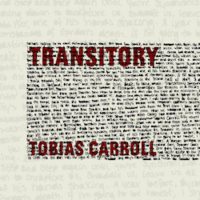In “Winter Montage, Hoboken Station,” the first story in Tobias Carroll’s debut short fiction collection Transitory, a man meets with an old friend at a bar in a train station. They’ve known each other since elementary school, though now, on the cusp of middle age, they live in different cities and see each other with decreasing frequency. The awkward space between them—they are not strangers, but no longer feel the ease of intimacy—is mirrored in their interjacent setting: a collection of train cars, a river, snowfall. It all reminds the narrator of another city in which he once resided, particularly of winter nights waiting at the airport’s light rail station to take him back home. “Transit,” he reflects, simply yet insightfully, “always reminds me of transit.”
Carroll is upfront about his collection’s motif. The stories are transitory in their brevity and their interest in incremental time, but also in their focus on transit: the unglamorous movement of people from one place to another. Traveling (as every traveler knows) is not the variegated experience that one imagines; it is mostly defined by monotony, by the sameness of airplanes, of train stops, of rental cars and chain restaurants. Traveling is a province unto itself, a borderland governed by its own logic and sensations. Whatever identities we may build for ourselves elsewhere in our lives, the stark anonymity of stations, ports, and depots lays us bare.
In “Spencer Hangs Over Newark,” the eponymous protagonist relishes the escape from normal life that travel provides. He is on a quest to return a wallet to the man from whom he stole it thirty years earlier. His victim has ironically spent much of the intervening decades in prison for counterfeit and fraud. Spencer plans to meet the man upon his release, to return the wallet and share a laugh, without concern for how the man might react. It’s as though the incidental nature of the trip removes the consideration of risk normally present in his life. Staring out the window of the plane, Spencer marvels at the insubstantiality of the world beneath him.
Below, he sees trucks and cars the size of gnats, tiny globes of light at the end of poles. Sees buildings, perfect squares and circles fringed with rust, mats of green dividing them… He can’t shake loose the feeling that their speed is somehow wrong, that the highway’s 65 miles per hour have had their danger stolen from where he’s sitting. Consider vantage the thief of velocity.
The collection is diverse in terms of style, with naturalistic stories shoulder-to-shoulder with more fabulistic tales. In “The Wenceslas Men,” the narrator is disturbed by a procession of impossibly tall figures that wander nightly outside the apartment where he temporarily resides. In “Why I Was Not In New Jersey For Christmas In 1997,” a distracted New York college student gets on the wrong subway car only to belatedly realize he’s boarded a transcontinental express to Los Angeles. In “Western Bridges,” a man develops a sudden phobia of “the Eastern seaboard and any craft with wheels,” and so must walk across the country in order to start a new life in Oregon. The stories all feel more or less of a piece, united by Carroll’s cerebral and deliberative prose. His narrators are romantics chastened by reality, or skeptics on a quest to be proven wrong. Many of the strongest stories operate in the spaces between the real and the surreal, in situations that are only as mysting as the reader allows them to be.
“Airport Hotel Ghost Tour,” for example, concerns a man awaiting a flight at the New Orleans airport. By the hotel soda machines he meets a stranger in a tailored suit who offers him a ghost tour of the property. The protagonist has an interest in ghost tours and their docents:
He had come to think of ghost tour purveyors as a kind of ghost themselves. They haunted, they circulated. The way dogs and their owners came to resemble one another, he thought. He’d been staring out into some ice-strewn sea when an image came to him of ghost tours spotlighting the restless souls of ghost tour guides, who in turn brought ghosts on their own tours of ghosts of an older generation.
As the tourist and tour guide move between the various ghostly sites of the hotel, the reader has the unnerving sense of watching one spirit following another.
This undermining of the exterior world characterizes Carroll’s project. He seeks to replicate the introversion of travel, the inadvertent solitude that leads inevitably to reflection. The in-betweenness of the setting is rife for circumspection. The stories read like they were created for consumption during moments of layover. The product of such moments, even: jotted down in airport lounges, struggling for whatever clarity might be reached before the next departure.
There is a compelling openness in Carroll’s storytelling method, as though he is working it out for his own benefit. His inquisitiveness never feels like a posture. The spiritual center of the collection is the New Jersey suburbs that ring New York, and something of that peripheral Jersey worldview is present in its pages: a reflexive sheepishness, an apologetic affinity for parking lots and industrial sprawl. Which isn’t to say there’s anything parochial about Carroll’s prose. He has a playful, poetic ear, and his sentences offer instances of assonance worthy of Gerard Manley Hopkins: “a time when dried pines still piled curbside”; “the hotel hung low-slung like a truncated letter U.”
This enthusiasm for language is in keeping with the other preoccupation of the collection, which is the lingering nature of art. The stories are full of remembered songs and VHS tapes, indie films and student paintings. People may be transitory, but through the years a work of art retains its emotional weight. Even art we no longer like. In “Stanton Sees, Stands, Stares,” the title character sifts absentmindedly through the stacks of a Los Angeles record store, recalling the hits of his youth.
Stanton remembers his year and a half of Warrant devotion; of listening to the title track again and again. Of playing it in the tape deck of his father’s car—that and the Damn Yankees album—on trips to the Brendan Byrne Arena, trips on the Palisades Parkway, trips to aquariums in Brooklyn and Camden. In retrospect, he’s tempted to call his father—tempted to call him from this very spot, no matter how awkward it may seem—and apologize.
Art has the power to transport, particularly when we are not at home and are therefore vulnerable to the wistfulness that can contaminate travel. The idea that art represents permanence in a disposable world is not original, but it is worth revisiting. Among ever-deteriorating relationships and migratory lifestyles, art represents a reliable constant, even if the exchange it facilitates is unidirectional and occurs between strangers.
In the penultimate story, “The Independence Shipping Company,” the narrator is a crewman on a converted ferry that shuttles books and vagabonds between Maine and Miquelon. The maritime life is imperfect, but it beats living on land, just like art may fall short of true communication but still represents the last best hope for contact with another soul. Beneath the shifting glow of the aurora, the narrator finds a semblance of permanence:
[W]hen I look to the sky and see the Lights, I see a correspondence, I see something up there that maybe isn’t meant to be read. But still. We perceive it. We watch it and we hope we can make sense of it. And I sit down and write, letters to a you I don’t even recognize. I watch and I hope and I wait, a year from now, ten years from now, to still feel that strange sense of connection.





